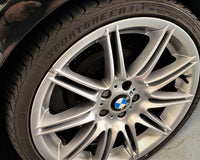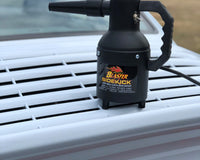As the chilly winds herald the arrival of winter, proactive measures to safeguard your vehicle become imperative. The transition to colder temperatures demands meticulous preparation to ensure your vehicle navigates through the season with ease. Let's delve deeper into essential steps to ready your vehicle for the challenges of winter driving.
Cabin Comfort and Functionality
Winter brings frigid temperatures, underscoring the importance of a well-functioning heating system. Test the heater and defroster to ensure they're functioning optimally. Clear vents of any debris, allowing warm air to circulate efficiently, ensuring comfort during freezing drives.
Brake System Optimization
Winter's slippery roads demand pristine braking performance. A thorough brake system inspection—checking brake pads, rotors, and fluid—ensures reliable braking, crucial for navigating icy or snow-covered roads. Addressing any issues beforehand averts potential risks.
Winter-Specific Windshield Care
A clear windshield is paramount for visibility. Replace worn wiper blades with winter-grade ones designed to combat ice and snow buildup. Additionally, stock up on winter washer fluid, formulated to prevent freezing, ensuring a clear view during inclement weather.
Engine Warm-Up Practice
In colder temperatures, allowing your vehicle's engine to warm up adequately before driving prevents premature wear. A brief warm-up period—roughly five minutes—helps the engine reach operating temperature, enabling optimal performance and reducing strain.
Winter Emergency Kit Essentials
Crafting a winter emergency kit could be a lifesaver. Essential items include a flashlight, blankets, non-perishable snacks, gloves, an ice scraper, and jumper cables. These provisions are invaluable in case of unexpected roadblocks or vehicle trouble.
Battery and Electrical System Check
The harsh cold can pose a threat to your vehicle's battery life. Ensure the battery's terminals are clean, tight, and free of corrosion. Consider a professional check-up if the battery is over three years old to gauge its health and readiness for winter.

Undercarriage Protection and Maintenance
Shielding the vehicle's undercarriage from the corrosive effects of road salt and moisture is vital. Thoroughly clean the undercarriage and apply a protective coating or rust inhibitor to safeguard against corrosion, ensuring longevity.
Enhanced Exterior Protection
The vehicle's exterior is subjected to harsh winter elements. Applying a high-quality wax or sealant creates a protective barrier, shielding the paint from road salt and chemical damage. Regular washes also prevent buildup, preserving the vehicle's appearance.
Four-Wheel Drive System Verification
Vehicles equipped with a four-wheel-drive system must undergo a functional test. Ensure the system engages smoothly and disengages without issues. A well-functioning 4WD system offers superior traction on snow-covered surfaces.
Proper Tire Care and Maintenance
Optimal tire condition is crucial for safe winter driving. Check tire pressure regularly and consider switching to winter tires for enhanced grip. Additionally, inspect tire tread depth to ensure adequate traction in icy conditions.
Fuel Management for Winter
Maintain a sufficient fuel level to prevent fuel line freezing during extremely cold temperatures. A fuller tank minimizes condensation, reducing the risk of moisture-related issues, especially in sub-zero conditions.
Garage Parking and Car Cover Usage
If feasible, park your vehicle in a garage to shield it from extreme cold. When parking outdoors, consider using a car cover to provide additional protection against snow, ice, and cold winds, preserving your vehicle's exterior.
Regular Maintenance and Fluid Checks
Regular maintenance, including checking fluid levels and replacing worn belts and hoses, ensures your vehicle's reliability throughout winter. Adequate preparation decreases the likelihood of breakdowns in challenging conditions.
Timely Winterization Planning
Winter car care necessitates timely planning and action. Commence your winter preparations well in advance to address any issues and equip your vehicle with everything needed to combat the challenges posed by winter weather.
Snow and Ice Removal Techniques
Removing snow and ice from your vehicle before driving is crucial for safety and visibility. Use a snow brush or a snow shovel to clear accumulated snow from the vehicle's roof, hood, and windows. Additionally, employing an ice scraper or de-icing solution helps eliminate ice buildup on windows and mirrors, ensuring clear visibility before hitting the road.
Effective Battery Care in Cold Conditions
Extreme cold can significantly affect your vehicle's battery performance. Consider investing in a battery insulation kit to shield the battery from the frigid temperatures. Furthermore, if your vehicle is not used frequently during winter, employing a trickle charger or maintaining periodic short drives can help preserve battery life.
Winter-Specific Tire Pressure Monitoring
Tire pressure tends to drop in colder temperatures, affecting tire performance and fuel efficiency. Regularly check tire pressure, ensuring it meets the manufacturer's recommendations. Adequate tire pressure ensures optimal traction and stability, crucial for safe winter driving.
Safe Driving Practices for Icy Roads
Winter conditions bring challenges like icy roads. Implementing safe driving practices, such as reducing speed, increasing following distances, and avoiding sudden maneuvers, minimizes the risk of skidding or losing control on icy surfaces, enhancing overall road safety.
Importance of Anti-Freeze Solution for Cooling System
Ensure the vehicle's cooling system contains an adequate mixture of antifreeze and water. This prevents the coolant from freezing in the engine, safeguarding against potential engine damage due to extreme cold temperatures.
Monitoring Vehicle Fluids in Chilly Weather
Check and maintain all vehicle fluids at recommended levels, including engine oil, transmission fluid, brake fluid, and coolant. Cold temperatures can impact fluid viscosity, affecting their performance. Adequate fluid levels guarantee smooth vehicle operation in winter conditions.
Emergency Preparedness on Winter Roads
In addition to the emergency kit, equip your vehicle with other essentials like a shovel, sand or kitty litter for traction, and a reflective warning sign. These items can be invaluable in case of getting stuck or stranded in snow or adverse weather conditions.
Winter Vehicle Service Inspection
Consider scheduling a professional service inspection before winter arrives. Trained technicians can conduct comprehensive checks, addressing potential issues, and ensuring your vehicle is in top condition to withstand the challenges of winter driving.
Conclusion
Winterizing your vehicle involves meticulous attention to detail, ensuring optimal performance and safety during harsh weather conditions. By adhering to these comprehensive winter car care measures, you fortify your vehicle against the adversities of winter driving, enhancing safety and preserving its longevity.




